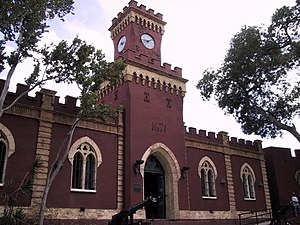Welcome to the Denmark Portal! | ||||

|

|

| |
Denmark is the smallest and southernmost of the Nordic countries. Unified in the 10th century, it is also the oldest. Located north of its only land neighbour, Germany, south-west of Sweden, and south of Norway, it is located in northern Europe. From a cultural point of view, Denmark belongs to the family of Scandinavian countries although it is not located on the Scandinavian Peninsula. The national capital is Copenhagen.
Denmark borders both the Baltic and the North Sea. The country consists of a large peninsula, Jutland, which borders Schleswig-Holstein; many islands, most notably Zealand, Funen, Vendsyssel-Thy, Lolland, and Bornholm; and hundreds of minor islands often referred to as the Danish Archipelago. Denmark has historically controlled the approach to the Baltic Sea, and those waters are also known as the Danish straits.
Denmark has been a constitutional monarchy since 1849 and is a parliamentary democracy. It became a member of the European Economic Community (now the European Union) in 1973. The Kingdom of Denmark also encompasses two off-shore territories, Greenland and the Faroe Islands, both of which enjoy wide-ranging home rule. The Danish monarchy is the oldest existing monarchy in Europe, and the national flag is the oldest state flag in continuous use.
Selected biography
Piet Hein (December 16, 1905 - April 17, 1996) was a scientist, mathematician, inventor, author, and poet, often writing under the Old Norse pseudonym "Kumbel" meaning "tombstone". His short poems, gruks (or grooks), first started to appear in the daily newspaper Politiken shortly after the Nazi Occupation in April 1940 under the signature Kumbel Kumbell.
Piet Hein popularized the use of the superellipse in architecture, urban planning, and furniture making, and he invented the super-egg or superellipsoid based on the superellipse.
Recently selected: Thorvald Stauning - Nicolas Steno - Knud Rasmussen
Selected picture

Image credit: : Mali.
Selected article
Norse society was based on agriculture and trade with other peoples and placed great emphasis on the concept of honour, both in combat and in the criminal justice system. It was, for example, unfair and wrong to attack an enemy already in a fight with another.
Their language, Old Norse, became the mother-tongue of present-day Nordic languages (notably including Danish).
Selected place
Famous for its main drag, known as Pusher Street, where hash and skunk weed were sold openly from permanent stands until 2004, it nevertheless does have rules forbidding 'hard drugs', such as cocaine, amphetamine, ecstasy and heroin. The region negotiated an arrangement with the Danish defence ministry (which still owns the land) in 1995. Since 1994, residents have paid taxes and fees for water, electricity, trash disposal, etc. The future of the area remains in doubt, though, as Danish authorities push for its removal.
Categories
Denmark topics
Things you can do
- Expand stubs:
Geography stubs · People stubs · Denmark stubs in general
Help us extend these stubs and make them real articles!
- Categorize:
Help us categorize Denmark-related articles
- WikiProjects:
Have a look at WikiProject Denmark, WikiProject Faroe Islands, WikiProject Greenland and WikiProject Norse history and culture
- Noticeboard:
Have a look at the Danish Wikipedians' notice board
- Geotag:
Find coordinates for these locations and tag them: articles missing geocoordinate data
Related portals
Northern Europe
Other countries
Associated WikiMedia
The following Wikimedia Foundation sister projects provide more on this subject:
-
 Commons
Commons
Free media repository -
 Wikibooks
Wikibooks
Free textbooks and manuals -
 Wikidata
Wikidata
Free knowledge base -
 Wikinews
Wikinews
Free-content news -
 Wikiquote
Wikiquote
Collection of quotations -
 Wikisource
Wikisource
Free-content library -
 Wikispecies
Wikispecies
Directory of species -
 Wikiversity
Wikiversity
Free learning tools -
 Wikivoyage
Wikivoyage
Free travel guide -
 Wiktionary
Wiktionary
Dictionary and thesaurus




Recent Comments